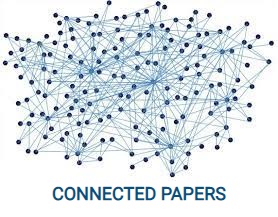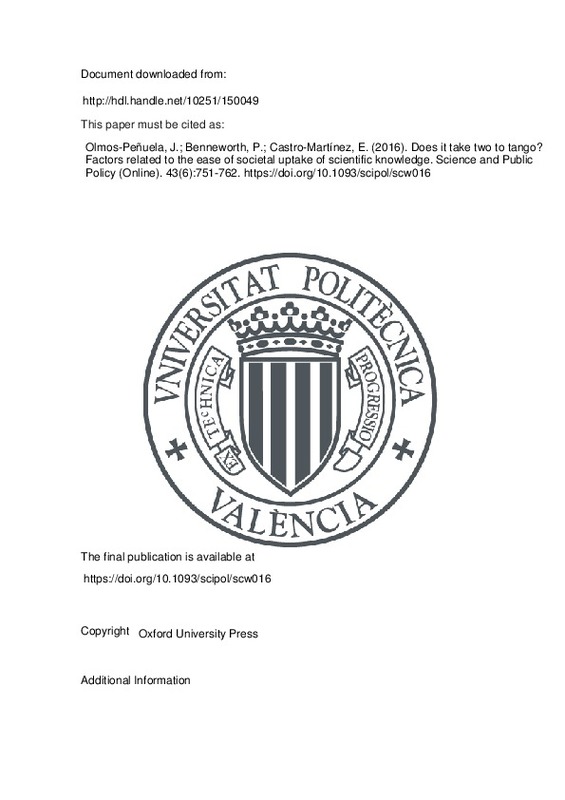Adviesraad-voor-Wetenschaps (2007) ‘Alfa en Gamma stralen.Valorisatiebeleid voor de Alfa- en Gammawetenschappen’. Rijswijk, the Netherlands: Adviesraad voor Wetenschaps- en Technologiebeleid.
Amin A. Cohendet P. (2004) Architectures of Knowledge: Firms, Capabilities, and Communities. Oxford, UK: OUP.
Baldini, N., Grimaldi, R., & Sobrero, M. (2007). To patent or not to patent? A survey of Italian inventors on motivations, incentives, and obstacles to university patenting. Scientometrics, 70(2), 333-354. doi:10.1007/s11192-007-0206-5
[+]
Adviesraad-voor-Wetenschaps (2007) ‘Alfa en Gamma stralen.Valorisatiebeleid voor de Alfa- en Gammawetenschappen’. Rijswijk, the Netherlands: Adviesraad voor Wetenschaps- en Technologiebeleid.
Amin A. Cohendet P. (2004) Architectures of Knowledge: Firms, Capabilities, and Communities. Oxford, UK: OUP.
Baldini, N., Grimaldi, R., & Sobrero, M. (2007). To patent or not to patent? A survey of Italian inventors on motivations, incentives, and obstacles to university patenting. Scientometrics, 70(2), 333-354. doi:10.1007/s11192-007-0206-5
Bate J. (2011) The Public Value of the Humanities. London: Bloomsbury.
Bateman T. S. Hess A. M. (2015) ‘Different personal propensities among scientists relate to deeper vs. broader knowledge contributions’. Proceedings of the National Academy of Sciences, 112: 3653–3658.
Becher T. Trowler P. R. (2001) Academic Tribes and Territories Intellectual Enquiry and the Culture of Disciplines. Buckingham, UK: Society for Research into Higher Education and Open University Press.
Behrens, T. R., & Gray, D. O. (2001). Unintended consequences of cooperative research: impact of industry sponsorship on climate for academic freedom and other graduate student outcome. Research Policy, 30(2), 179-199. doi:10.1016/s0048-7333(99)00112-2
Benner, C. (2003). Learning Communities in a Learning Region: The Soft Infrastructure of Cross-Firm Learning Networks in Silicon Valley. Environment and Planning A: Economy and Space, 35(10), 1809-1830. doi:10.1068/a35238
Benneworth, P. (2015). Tracing how arts and humanities research translates, circulates and consolidates in society.. How have scholars been reacting to diverse impact and public value agendas? Arts and Humanities in Higher Education, 14(1), 45-60. doi:10.1177/1474022214533888
Benneworth P. Olmos-Peñuela J. (2014) ‘Resolving tensions of research utilization: The value of a usability-based approach’: INGENIO (CSIC-UPV) Working Paper Series. Valencia: INGENIO.
Boschma, R. (2005). Proximity and Innovation: A Critical Assessment. Regional Studies, 39(1), 61-74. doi:10.1080/0034340052000320887
Bozeman, B. (2000). Technology transfer and public policy: a review of research and theory. Research Policy, 29(4-5), 627-655. doi:10.1016/s0048-7333(99)00093-1
Bozeman, B. (2002). Public‐Value Failure: When Efficient Markets May Not Do. Public Administration Review, 62(2), 145-161. doi:10.1111/0033-3352.00165
Bozeman B. (2012) ‘Public values concepts and criteria: The case for “progressive opportunity” as a criterion’. Paper prepared for Creating Public Values Conference, held 20–22 September 2012, Minneapolis, MN < http://www.leadership.umn.edu/documents/Bozeman6.4.12wtitlepage.pdf> accessed 23 Mar 2015.
Brewer J. D. (2013) The Public Value of the Social Sciences: An Interpretive Essay. London: Bloomsbury.
Breznitz, S. M., & Feldman, M. P. (2010). The engaged university. The Journal of Technology Transfer, 37(2), 139-157. doi:10.1007/s10961-010-9183-6
Consejo Superior de Investigaciones Científicas (2012) ‘Memoria anual del CSIC 2011’. Madrid: Consejo Superior de Investigaciones Científicas <http://documenta.wi.csic.es/alfresco/downloadpublic/direct/workspace/SpacesStore/81d3f71c-819c-4787-9147-8c18b2d64fcb/CSIC_MEMORIA_2011_alta.pdf> accessed 17 Sep 2013.
Crossick G . (2009) ‘So who now believes in the transfer of widgets?’ Paper presented at Knowledge Future Conference, held 16–7 October 2009, London <http://www.london.ac.uk/fileadmin/documents/about/vicechancellor/Knowledge_transfer_without_widgets.pdf> accessed 20 Nov 2011.
Dance, A. (2013). Impact: Pack a punch. Nature, 502(7471), 397-398. doi:10.1038/nj7471-397a
D’Este P. Llopis O. Yegros A. (2013) ‘Conducting pro-social research: Cognitive diversity, research excellence and awareness about the social impact of research’: INGENIO (CSIC-UPV) Working Paper Series. Valencia: INGENIO.
D’Este, P., & Perkmann, M. (2010). Why do academics engage with industry? The entrepreneurial university and individual motivations. The Journal of Technology Transfer, 36(3), 316-339. doi:10.1007/s10961-010-9153-z
Donovan, C. (2007). The qualitative future of research evaluation. Science and Public Policy, 34(8), 585-597. doi:10.3152/030234207x256538
Elam, M., & Bertilsson, M. (2003). Consuming, Engaging and Confronting Science. European Journal of Social Theory, 6(2), 233-251. doi:10.1177/1368431003006002005
Fromhold-Eisebith M. Werker C. Vojnic M. (2014) ‘Tracing the social dimension in innovation networks’ in The Social Dynamics of Innovation Networks, Rutten R. Benneworth P. Irawati D. Boekema F. (eds), pp. 221–39. London: Routledge.
Garland, R. (2012). The humanities: plain and simple. Arts and Humanities in Higher Education, 11(3), 300-312. doi:10.1177/1474022212438754
Gertner, D., Roberts, J., & Charles, D. (2011). University‐industry collaboration: a CoPs approach to KTPs. Journal of Knowledge Management, 15(4), 625-647. doi:10.1108/13673271111151992
Gibbons M. Limoges C. Nowotny H. Schwartzman S. . (1994) The New Production of Knowledge: The Dynamics of Science and Research in Contemporary Societies. London: Sage.
Gulbrandsen M. (2012) ‘“But Peter’s in it for the money”–the liminality of entrepreneurial scientists’. TIK Working Papers on Innovation Studies, No. 20120323 <http://www.sv.uio.no/tik/InnoWP/Gulbrandsen%2020120323. pdf> accessed 20 Mar 2015.
Gulbrandsen, M., & Smeby, J.-C. (2005). Industry funding and university professors’ research performance. Research Policy, 34(6), 932-950. doi:10.1016/j.respol.2005.05.004
Hanney S. R. Gonzalez-Block M. A. Buxton M. J. Kogan M. (2003) ‘The utilisation of health research in policy-making: Concepts, examples and methods of assessment’. Health Research Policy and Systems <http://www.health-policy-systems.com/content/pdf/1478-4505-1-2.pdf> accessed 11 Feb 2016.
Hessels, L. K., & van Lente, H. (2008). Re-thinking new knowledge production: A literature review and a research agenda. Research Policy, 37(4), 740-760. doi:10.1016/j.respol.2008.01.008
Isaksen, A., & Karlsen, J. (2010). Different Modes of Innovation and the Challenge of Connecting Universities and Industry: Case Studies of Two Regional Industries in Norway. European Planning Studies, 18(12), 1993-2008. doi:10.1080/09654313.2010.516523
Jacobson, N., Butterill, D., & Goering, P. (2004). Organizational Factors that Influence University-Based Researchers’ Engagement in Knowledge Transfer Activities. Science Communication, 25(3), 246-259. doi:10.1177/1075547003262038
Kitcher P. (2003) ‘What kinds of science should be done?’ in Living with the Genie: Essays on Technology and the Quest for Human Mastery Lightman A. Sarewitz D. Desser C. (eds), pp. 201–24. Washington, DC: Island Press.
Lam, A. (2011). What motivates academic scientists to engage in research commercialization: ‘Gold’, ‘ribbon’ or ‘puzzle’? Research Policy, 40(10), 1354-1368. doi:10.1016/j.respol.2011.09.002
Latour B. Woolgar S. (1979) Laboratory Life: The Social Construction of Scientific Facts. London: Sage.
Lee, Y. S. (1996). ‘Technology transfer’ and the research university: a search for the boundaries of university-industry collaboration. Research Policy, 25(6), 843-863. doi:10.1016/0048-7333(95)00857-8
Lee, Y. S. (2000). The Journal of Technology Transfer, 25(2), 111-133. doi:10.1023/a:1007895322042
Lowe, R. A., & Gonzalez-Brambila, C. (2007). Faculty Entrepreneurs and Research Productivity. The Journal of Technology Transfer, 32(3), 173-194. doi:10.1007/s10961-006-9014-y
Nowotny H. Scott P. Gibbons M. (2001) Re-Thinking Science: Knowledge and the Public in an Age of Uncertainty. Argentina: SciELO.
O’Shea, R. P., Allen, T. J., Chevalier, A., & Roche, F. (2005). Entrepreneurial orientation, technology transfer and spinoff performance of U.S. universities. Research Policy, 34(7), 994-1009. doi:10.1016/j.respol.2005.05.011
Olmos-Penuela, J., Benneworth, P., & Castro-Martinez, E. (2013). Are «STEM from Mars and SSH from Venus»?: Challenging disciplinary stereotypes of research’s social value. Science and Public Policy, 41(3), 384-400. doi:10.1093/scipol/sct071
Olmos-Peñuela, J., Benneworth, P., & Castro-Martínez, E. (2015). Are sciences essential and humanities elective? Disentangling competing claims for humanities’ research public value. Arts and Humanities in Higher Education, 14(1), 61-78. doi:10.1177/1474022214534081
Olmos-Peñuela, J., Benneworth, P., & Castro-Martínez, E. (2015). What Stimulates Researchers to Make Their Research Usable? Towards an ‘Openness’ Approach. Minerva, 53(4), 381-410. doi:10.1007/s11024-015-9283-4
Ramos-Vielba, I., Sánchez-Barrioluengo, M., & Woolley, R. (2015). Scientific research groups’ cooperation with firms and government agencies: motivations and barriers. The Journal of Technology Transfer, 41(3), 558-585. doi:10.1007/s10961-015-9429-4
Rhoten, D., & Pfirman, S. (2007). Women in interdisciplinary science: Exploring preferences and consequences. Research Policy, 36(1), 56-75. doi:10.1016/j.respol.2006.08.001
Roach, M., & Sauermann, H. (2010). A taste for science? PhD scientists’ academic orientation and self-selection into research careers in industry. Research Policy, 39(3), 422-434. doi:10.1016/j.respol.2010.01.004
Salter, A. J., & Martin, B. R. (2001). The economic benefits of publicly funded basic research: a critical review. Research Policy, 30(3), 509-532. doi:10.1016/s0048-7333(00)00091-3
Sarewitz, D., & Pielke, R. A. (2007). The neglected heart of science policy: reconciling supply of and demand for science. Environmental Science & Policy, 10(1), 5-16. doi:10.1016/j.envsci.2006.10.001
New, B. (1997). The rationing debate: Defining a package of healthcare services the NHS is responsible for The case for. BMJ, 314(7079), 498-498. doi:10.1136/bmj.314.7079.498
Shane, S. (2000). Prior Knowledge and the Discovery of Entrepreneurial Opportunities. Organization Science, 11(4), 448-469. doi:10.1287/orsc.11.4.448.14602
Slaughter S. Leslie L. L. (1997) Academic Capitalism: Politics, Policies, and the Entrepreneurial University. Baltimore, MD: Johns Hopkins University Press.
Small H. (2013) The Value of the Humanities. Oxford, UK: OUP.
Spaapen, J., & van Drooge, L. (2011). Introducing «productive interactions» in social impact assessment. Research Evaluation, 20(3), 211-218. doi:10.3152/095820211x12941371876742
Stephan, P. E., & Levin, S. G. (1993). Age and the Nobel prize revisited. Scientometrics, 28(3), 387-399. doi:10.1007/bf02026517
Stokes D. E. (1997) Pasteur’s Quadrant: Basic Science and Technological Innovation. Washington, DC: Brookings Institution Press.
Tartari, V., & Breschi, S. (2012). Set them free: scientists’ evaluations of the benefits and costs of university-industry research collaboration. Industrial and Corporate Change, 21(5), 1117-1147. doi:10.1093/icc/dts004
Thursby, J. G., & Thursby, M. C. (2004). Are Faculty Critical? Their Role in Universityâ Industry Licensing. Contemporary Economic Policy, 22(2), 162-178. doi:10.1093/cep/byh012
Trowler P. Saunders M. Bamber V. (2012) Tribes and Territories in the 21st Century: Rethinking the Significance of Disciplines in Higher Education. New York: Taylor and Francis.
Van Looy, B., Ranga, M., Callaert, J., Debackere, K., & Zimmermann, E. (2004). Combining entrepreneurial and scientific performance in academia: towards a compounded and reciprocal Matthew-effect? Research Policy, 33(3), 425-441. doi:10.1016/j.respol.2003.09.004
Van Rijnsoever, F. J., & Hessels, L. K. (2011). Factors associated with disciplinary and interdisciplinary research collaboration. Research Policy, 40(3), 463-472. doi:10.1016/j.respol.2010.11.001
Van Rijnsoever, F. J., Hessels, L. K., & Vandeberg, R. L. J. (2008). A resource-based view on the interactions of university researchers. Research Policy, 37(8), 1255-1266. doi:10.1016/j.respol.2008.04.020
Weingart, P. (2009). Editorial for Issue 47/3. Minerva, 47(3), 237-239. doi:10.1007/s11024-009-9131-5
Zahra, S. A., Van de Velde, E., & Larraneta, B. (2007). Knowledge conversion capability and the performance of corporate and university spin-offs. Industrial and Corporate Change, 16(4), 569-608. doi:10.1093/icc/dtm018
Zomer, A. H., Jongbloed, B. W. A., & Enders, J. (2010). Do Spin-Offs Make the Academics’ Heads Spin? Minerva, 48(3), 331-353. doi:10.1007/s11024-010-9154-y
[-]







![[Cerrado]](/themes/UPV/images/candado.png)


